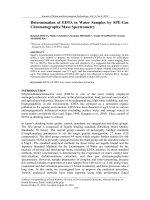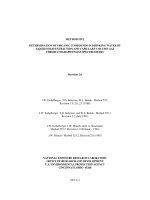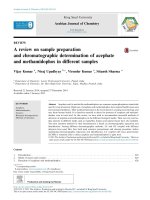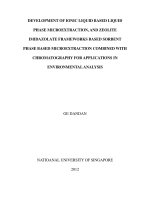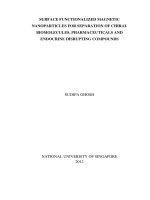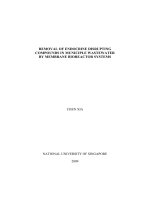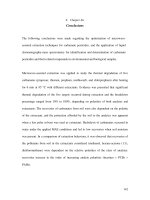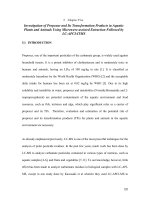Determination of endocrine disrupting compounds in environmental samples using microextraction combined with gas chromatography mass spectrometry
Bạn đang xem bản rút gọn của tài liệu. Xem và tải ngay bản đầy đủ của tài liệu tại đây (2.6 MB, 157 trang )
DETERMINATION OF ENDOCRINE DISRUPTING
COMPOUNDS IN ENVIRONMENTAL SAMPLES USING
MICROEXTRACTION COMBINED WITH GAS
CHROMATOGRAPHY/MASS SPECTROMETRY
CHANBASHA BASHEER
NATIONAL UNIVERISITY OF SINGAPORE
2004
DETERMINATION OF ENDOCRINE DISRUPTING
COMPOUNDS IN ENVIRONMENTAL SAMPLES USING
MICROEXTRACTION COMBINED WITH GAS
CHROMATOGRAPHY/MASS SPECTROMETRY
CHANBASHA BASHEER
(M. Sc.)
A THESIS SUBMITTED
FOR THE DEGREE OF DOCTOR OF PHILOSOPHY
DEPARTMENT OF CHEMISTRY
NATIONAL UNIVERISITY OF SINGAPORE
2004
PREFACE
Endocrine disrupting compounds (EDCs) are defined as exogenous substances
(such as organotins, alkylphenols, bisphenol-A, organochlorine pesticides, polychlorinated
biphenyls, polycyclic aromatic hydrocarbons, phthalates and triazine herbicides etc.). They
cause adverse health effects in an intact organism or its progeny as a consequence of
changes in its endocrine system. The alarm over their potential impacts has been sounded
recently by several research commissions and regulatory agencies, underlining the
necessity to develop diagnostic and prognostic tools to identify exposure to, and the effects
of these EDCs on humans and wildlife. Endocrine disruption mechanisms include
antagonism of hormones and inhibition of the synthesis and metabolism of hormones.
Many of the known EDCs are environmental estrogens, and it is for this reason that the
phenomenon of the feminization in wildlife has been observed in the environment.
Potential hazards and health effects posed by EDCs has increased awareness, and an urgent
need to establish new analytical methods to quantify EDCs and correlate their presence in
the environment with human health impact has been recognized. Lack of data from
biological materials and water samples for these contaminants indicates that there is a
shortage of suitable, simple analytical techniques for their quantification. Current
techniques for EDCs suffer from low detection limits and poor selectivity and sensitivity of
extraction (enrichment). Before studying the effects of EDCs, there is need to accurately
determine EDC concentrations in environmental samples. A database is needed to identify
the distribution and fate of EDCs in Singapore’s environment. In this study, emphasis has
been on developing a wide range of miniaturized extraction procedures that are simple and
highly efficient.
i
The first part of the thesis addresses the general introduction to EDCs and micro
analytical techniques. In the second part, new analytical techniques based on solid-phase
microextraction (SPME) techniques for the complex matrices such as seawater, bovine
milk and sewage sludge samples were developed. Further development of hollow fiber
protected liquid-phase microextraction (HFM-LPME) techniques for wide range of EDCs
in seawater, rainwater and blood plasma samples. The third part of thesis deals with the
analysis of EDCs in solid matrices such as marine sediments using microwave-assisted
digestion (MAD) coupled with HFM-LPME. Part four give the conclusion of this work.
The analytical techniques developed in this study were compared with traditional
techniques and applied to the analysis of EDCs in environmental samples. The novel
microextraction techniques have more advantages than the conventional procedures such
as simple, more efficient for complex environmental matrices, less amount of sample and
solvent were required.
ii
ACKNOWLDGEMENTS
I am grateful to my supervisor Professor Hian Kee Lee for his invaluable suggestions,
moral support and encouragement throughout this work
I appreciated the financial assistance provided by the National University of Singapore
during my Ph.D. candidacy. Support by the United Nations University, Japan through their
“Environmental Monitoring and Governance in the East Asian Coastal Hydrosphere”
programme is gratefully appreciated
My deepest thanks to Professor. Li Fong Yau Sam, Associate Professor Jeffrey Phillip
Obbard, Dr. Koh Siang Tan, and Dr. Rajashekhar Balasubramanian for their help in
various ways.
My thanks to Madam Frances Lim for her technical assistance during my work
I extended my thanks to my colleagues for their help in comments and suggestions to my
projects
Finally, I am indebted to my wife Imthiyaz and my parents for their constant motivation
and encouragement
iii
LIST OF PUBLICATIONS
[1] C. Basheer, H. K. Lee, J. P. Obbard. Determination of organochlorine pesticides in
seawater using liquid-phase hollow fibre membrane microextraction and gas
chromatography-mass spectrometry. J CHROMATOGR A. (2002), 968 (1-2): 191-199
[2] C. Basheer, R. Balasubramanian, H. K. Lee. Determination of organic micropollutants
in rainwater using hollow fiber membrane/liquid-phase microextraction combined with gas
chromatography–mass spectrometry, J CHROMATOGR A. (2003), 1016 (1): 11-20
[3] C. Basheer, H. K. Lee, J. P. Obbard. Application of liquid-phase microextraction and
gas chromatography–mass spectrometry for the determination of polychlorinated biphenyls
in blood plasma, J CHROMATOGR A. (2004), 1022 (1): 161-169
[4] C. Basheer and H. K. Lee. Hollow Fiber Membrane Protected SPME of Triazine
Herbicides in Bovine Milk and Sewage Sludge Samples, J CHROMATOGR A. (2004),
1047 (2): 189-194
[5] C. Basheer and H. K. Lee. Determination of Endocrine Disrupting Alkylphenols and
Bisphenol-A by Headspace Solid-Phase Microextraction (In preparation)
iv
[6] C. Basheer and H. K. Lee. Analysis of Endocrine Disrupting Alkylphenols and
Bisphenol-A using Hollow Fiber-Protected Liquid-phase Microextraction Coupled with
Injection Port-Derivatization Gas Chromatography/Mass Spectrometry, J
CHROMATOGR A. (2004), 1057 (1, 2): 163-169
[7] C. Basheer, H. K. Lee, J. P. Obbard. Analysis of Persistent Organic Pollutants in
Singapore’s Coastal Sediments using Microwave-assisted Digestion Coupled with HFM-
LPME, J CHROMATOGR A. (2005), 1068 (2): 221-228
CONFERENCE PAPERS
[8] C. Basheer, K. S. Tan, H. K. Lee. Endocrine Disrupting Chemicals in Singapore
Coastal Environment (Environmental Governance and Analytical Techniques:EDCs in
East Asian Coastal Hydrosphere. University of Malaya, Malaysia, 17 - 18 April 2000)
[9] C. Basheer, K. S. Tan, H. K. Lee. Preliminary Survey of Endocrine Disrupting Phenols
from Singapore Coastal Environment (Industries and EDC Pollution: Co-organized by
Korean Ocean Research and Development Institute and The Kwangju Institute of Science
and Technology, Seoul, Korea; 16-17 April 2001)
[10] C. Basheer, H. K. Lee. Novel Extraction Techniques for Endocrine Disrupting
Compounds (American Chemical Society, Analytical Division, Chicago, 26-30 August
2001)
v
[11] C. Basheer, K. S. Tan, H. K. Lee. Quantification of alkylphenols and bisphenol-A
from Singapore Coastal Environment (American Chemical Society, Environmental
Chemistry Division, Chicago, 26-30 August 2001)
vi
TABLE OF CONTENTS
Preface
i
Acknowledgements
iii
List of publications
iv
Table of contents
vii
List of abbreviations
ix
PART I
Chapter 1: Introduction
1.1 General Introduction to Endocrine Disrupting Chemicals
1
1.2 Microextraction Techniques
7
PART II
Chapter 2: Analysis of Aqueous Samples using Microextraction
Combined with GC/MS
2.1 Headspace Solid-Phase Microextraction with On-Fiber
Derivatization
24
2.2 Hollow Fiber Membrane-Protected SPME 39
vii
2.3 Hollow Fiber Membrane-Protected Liquid-Phase Microextraction
Coupled with Injection Port-Derivatization Gas Chromatography/Mass
Spectrometry
54
2.4
Hollow Fiber Membrane-Protected Liquid-Phase Microextraction for
Seawater Samples Analysis
66
2.5
Hollow Fiber Membrane-Protected Liquid-Phase Microextraction for
Rainwater Sample Analysis
78
2.6
Hollow Fiber Membrane-Protected Liquid-Phase Microextraction for
Blood Plasma Sample Analysis
91
PART III
Chapter 3: Analysis of Solid Samples using Microextraction
Combined with GC/MS
3.1
Analysis of Singapore’s Coastal Sediments using Microwave-assisted
Digestion Coupled with HFM-LPME
107
PART IV
Conclusions
130
viii
LIST OF ABBREVIATIONS
ASE
Accelerated solvent extraction
APs
Alkylphenols
BPA
Bisphenol-A
CE
Capillary electrophoresis
DI-SPME
Direct immersion-SPME
d. wt
Dry weight
ECD
Electron capture detector
EDCs
Endocrine disrupting compounds
GC
Gas chromatography
GC/MS
Gas chromatography–mass spectrometry
HS-SPME
Headspace-SPME
HFM-SPME
Hollow fiber protected-SPME
HFM-LPME
Hollow fiber protected-LPME
LC
Liquid chromatography
LLE
Liquid-liquid extraction
LLLE
Liquid-liquid-liquid microextraction
LPME
Liquid-phase microextraction
LOD
Limit of detection
MASE
Microwave assisted solvent extraction
MAD
Microwave digestion
OCPs
Organochlorine pesticides
PA
Polyacrylate
ix
PAHs
Polycyclic aromatic hydrocarbons
PCBs
Polychlorinated biphenyls
PDMS
Polydimethylsiloxane
PDMS/DVB
Polydimethylsiloxane/Divinyl benzene
POPs
Persistent organic pollutants
RSDs
Relative standard deviations
SPE
Solid-phase extraction
SFE
Supercritical fluid extraction
SPME
Solid-phase microextraction
SIM
Selective ion monitoring
USEPA
United States Environmental Protection
Agency
UV
Ultraviolet
WHO
World Health Organization
x
PART I
CHAPTER 1: GENERAL INTRODUCTION TO
ENDOCRINE DISRUPTING CHEMICALS AND
MICROANALYTICAL TECHNIQUES
1.1 General introduction to endocrine disrupting compounds
The issue of endocrine disrupting compounds (EDCs) in the environment is a
serious concern. A number of scientific publications have suggested a decline in human
semen quality, an increase in testicular abnormalities and breast cancer over the past 50
years. USEPA has listed 84 compounds or group of compounds as top priority EDCs,
which are likely to produce human toxic effects. Some of the EDCs are highly persistent
and easily accumulate in adipose tissue, blood and breast milk via food chain. The ability
to undergo long-range atmospheric transport means that they are now ubiquitous in the
global environment.
Research into EDCs in the context of their impact on animal and human endocrine
systems is a relatively new field. Singapore is one of the world's busiest ports with many
industries and refineries located on the coastline. Every year the number of ships calling at
the port of Singapore is significantly increasing from 1996-2002 [1], and the use of
tributyltin (an EDC) is not controlled locally. Expectedly, the coastal environment is open
to pollution to undesirable chemicals, including EDCs. Till date, there have been no
systematic studies conducted on the monitoring and measurements of EDCs in the local
marine environment. Meanwhile, desalination of seawater, seafood cultivation, recycling
of municipal waste and air quality during forest fires in the region should be considered, as
they all have an impact on prevailing atmospheric EDC concentrations. These chemical
groups are alkylphenols and bisphenol-A, organochlorine pesticides, polycyclic aromatic
hydrocarbons, polychlorinated biphenyls and triazine herbicides.
1
1.1.1 Alkylphenols and bisphenol-A
Alkylphenols ethoxylates are a class of surfactants used extensively in the last 50
years as detergents in industrial cleaners, wetting agents, emulsifiers and in domestic soaps
[2]. Recent evidence has indicated a linkage between these surfactants and adverse changes
in the reproductive health and fertility of animals and humans [3]. Alkylphenols (APs)
such as octylphenols, nonylphenols and pentachlorophenol (PCP) and their degraded
products are mainly discharged from industrial and municipal effluent treatment plants [4].
Octylphenol is also used in a variety of products such as plastic and plastic materials. Vom
Saal [5] found that exposure of octylphenols caused significantly lower daily sperm
production in mice. Nonylphenols and bisphenol-A represent the primary focus of concern
in this respect. Nonylphenols are used as active ingredients in spermicides, antioxidants
and stabilizers in the plastic (polyvinyl chloride, polystyrene) industries and as emulsifiers
in lubricant oils. It has been shown that exposure to parts-per-billion (ppb) doses of
nonylphenol inhibit ATP (adenosine triphosphate) synthesis in the mitochondria [6]. Evan
et al. [7] recently found that nonylphenols can also induce imposex in marine snails at low
concentrations. Pentachlorophenol (PCP) is used in insecticide manufacturing, and in the
pulp industries. Women chronically exposed to wood preservatives containing PCP may
suffer from infertility and adrenal insufficiency [8].
Bisphenol-A (BPA) is used in the production of epoxy resin and polycarbonate
plastics, used in many food and drink packaging applications. Although, Dodds & Lawson
[9] in 1938 noted estrogenic activity of BPA, it is only in recent years that these
compounds began to receive more attention. BPA-containing resin is commonly used as
liquors to coat metal products such as food cans, bottle taps and water supply pipes. Recent
2
studies found BPA in canned food samples at 80 ppb levels; this is 27 times greater than
the amount reported to induce cancer [10]. In a survey, it is estimated that 109 tons of BPA
containing products were released into the environment from various sources. Like diethyl
stilbestrol (DES), BPA is capable of binding to DNA after metabolic activation. BPA
exhibits estrogenic properties at low concentrations and Howdeshell, et al [11] showed that
trans-placental exposure of low doses of BPA in mice could bring on early puberty in
females.
APs and BPA enter the marine environment through effluent discharge in the form,
or as part, of surfactants in industrial and domestic waste. Research into EDCs, in the
context of their environmental impact, is a relatively new field of interest. Only few
publications have been reported elsewhere on APs and BPA concentrations in the marine
environment [12-15].
1.1.2. Organochlorine pesticides
Public concern over organochlorine pesticide (OCPs) contamination of the
environment has risen over recent decades to the extent that it has now become a
significant food safety issue. These chemicals are known to disrupt the hormone endocrine
system and induce cancer in a range of organisms, thereby posing a significant risk to
natural ecosystems and human health [16]. The use of OCPs is tightly regulated in the
developed world, but OCPs, including DDT and hexachlorocyclohexane are still widely
used in many developing countries for agriculture and disease control [17]. OCPs have a
very low solubility in water, are fat soluble, resist metabolic degradation and have a
propensity to bioaccumulate in the food chain. High concentrations of OCPs have been
3
detected in bird raptors, marine mammals and human breast milk [18, 19]. Chlorinated
organic compounds have a wide range of industrial and agricultural applications, and
include the pesticides DDT (p,p’-dichlorodiphenyl trichlorethane) and Lindane (γ-
hexachlorocyclohexane), as well as the PCBs. The latter have been used historically in an
extensive range of industrial applications, including dielectric fluids in electrical
transformers. Such chemicals can readily enter the aquatic environment via atmospheric
transport, ground water leaching, soil run-off, and sewage discharge [20].
1.1.3. Polycyclic aromatic hydrocarbons
Polycyclic aromatic hydrocarbons (PAH) are ubiquitous pollutants that can now be
detected in a wide-range of environmental matrices, both biotic and abiotic [20]. The
introduction of these compounds into the environment via different processes (e.g.
atmospheric deposition, sewage and industrial discharges, oil spillages etc) has resulted in
their accumulation in both human and ecological food chains [21]. Some PAH are known
or suspected carcinogens and mutagens, and thus their potential hazards risk to human
health and the natural environment cannot be underestimated [22]. PAH is mainly formed
under high-temperature synthesis, incomplete burning of organic fuel or as a result of
thermal impact on organic matter. Forest fires and precipitation washout of atmospheric
particulates are known major contributing factors to the burden of PAH in the environment
[23, 24]. For example, during the widespread forest fire incident in Indonesia in 1997, air
quality in Southeast Asia was severely impaired as a result of the atmospheric emission of
PAH and a range of other organic pollutants [25]. Industrial wastes and domestic sewage
often also contain high concentrations of particulate and soluble PAH, and together with
4
surface runoff from urban catchments and atmospheric deposition represent the main
sources of high molecular weight PAH into the aquatic environment.
PAH account for approximately 20% of total hydrocarbons present in crude oil, and
are the most metabolically toxic of all the petroleum compounds
[26]. Oil spillage is a
global problem where for example, in 1999; approximately 32.2 million gallons (109,400
tons) of oil were spilled worldwide into marine and terrestrial environments as the result of
over 250 incidents. The Port of Singapore is the one of the world’s busiest, where the total
cargo handled in January 2002 alone was in excess of 28.2 million tones [1]. Singapore’s
coastal areas have also been extensively developed to support the petroleum industry,
where the country, is home to the world’s third largest petroleum refining centre with a
processing capacity in excess of 1.3 M barrels of crude oil per day [27]. Singapore and the
neighboring countries of Malaysia and Indonesia have experienced ten major oil spill
incidents between 1993 and 2002, including a major spillage of 28,500 tones of crude oil
in the Singapore Straits in October 1997 [28]. With continued industrial development and
shipping activity within the coastal region of South East Asia as a whole, there is clearly an
increasing risk of adverse regional marine contamination.
1.1.4. Polychlorinated biphenyls
Polychlorinated biphenyls (PCBs) are potent environmental contaminants due to
their propensity to accumulate in biological tissues, persistence and ubiquity in the global
environment [29-31]. They were first manufactured commercially in 1929 and were
subsequently used in many different types of products including hydraulic fluid, casting
wax, pigments, plasticizers, and dielectric fluids. During the 1970's, health and
5
environmental risks associated PCBs led to the U.S. Toxic Substances Control Act of
1976, which directed the U.S. Environmental Protection Agency (EPA) to ban PCB
manufacture, as well as regulate PCB use and disposal. However, PCB contamination from
historic uses and dumping is widespread, where improper storage and disposal has resulted
in contamination of most environmental media. As a result, many forms of wildlife have
become contaminated with PCB's [32, 33] and in recent years, there has been increasing
concern about the toxicological implications of PCBs on human health. Many publications
have specifically identified and quantified PCB congeners in human milk, adipose tissue
and blood samples [34, 35]. PCBs readily accumulate in the food chain, especially in meat,
fish, and dairy products due to their lipophilic nature and low water solubility. It is now
evident that PCBs are transferred from mother to fetus and newborn babies via blood
exchange in the placenta and to newborn infants via breast milk [36-39]. Trace amount of
PCB congeners have also been associated with endocrine disruption and a higher incidence
of fetal miscarriage [40].
1.1.5. Triazine herbicides
Triazine herbicides, such as simazine and atrazine are widely applied to corn, soybean,
wheat, barley, and sorghum productions for controlling broadleaf weed and grass [41, 42].
Residues of the herbicides have been detected in soil and surface waters in areas where the
agrochemicals have been used, owing to their persistence and relatively high solubility [43,
44]. Studies on the toxic effects of atrazine in fish have indicated a great variability in the
responses, depending upon the dose and the species, with lethal concentrations [45]. The
possibility of interactions between atrazine and the endocrine system of organisms has
6
been the focus of several studies. In humans, long-term exposure is suspected to increase
the risk of breast and ovarian cancers [46, 47].
1.2. Microextraction techniques
Trace amounts of EDCs pose great risk to human health thus there is increasingly
stringent legislation for maximum allowable levels for pollutants. Analytical detection
limits have improved with the development of highly sensitive analytical instrumentation
and sample enrichment procedures [48, 49].There is increasing demand on analytical
procedures in terms of achieving high enrichment factors and miniaturization to determine
ultratrace levels of EDCs in complex environmental samples. In sample preparation,
various parameters influence the accuracy of analysis such as sample matrix effects, loss of
analytes during multi-step operations, and selection of optimum extraction conditions.
However, the traditional sample preparation techniques are time consuming, and laborious
which leads to analytes loss, and also use large volume of toxic solvents. In this respect,
miniaturizing sample preparation procedures has become an important goal for analytical
chemistry [50].
1.2.1. Analytical technique for solid matrices
Microextraction techniques are economically and environmentally attractive
alternatives to the conventional procedures. Microwave-assisted solvent extraction
(MASE), supercritical extraction (SFE) and accelerated solvent extraction (ASE) are the
current extraction techniques for solid samples.
7
1.2.1.1. Microwave-assisted solvent extraction (MASE)
Microwave-assisted extraction methodology has been widely used for the
extraction of different compounds from soil and sediment samples. One of these
techniques is microwave-assisted solvent extraction (MASE). MASE requires smaller
volumes of extractant and shorter periods for analysis compared to Soxhlet extraction. The
ability to rapidly heat the sample solvent mixture is inherent to MASE and is the main
advantage of this technique. By using closed vessels the extraction can be performed at
elevated temperatures, thereby accelerating the mass transfer of target compounds from the
sample matrix. In addition, sample throughput is increased as several samples can be
extracted simultaneously. In most cases recoveries of analytes and reproducibility are
improved compared to conventional techniques, as shown in several applications [51].
The principle of heating using microwave energy is based on the direct effect of
microwaves on molecules by ionic conduction and dipole rotation. In many applications
these two mechanisms take place simultaneously. Ionic conduction is the electrophoretic
migration of ions when an electromagnetic field is applied. The resistance of the solution
to this flow of ions will result in friction and, thus, heat the solution. The ability of a
solvent to absorb microwave energy and pass it on in the form of heat to other molecules
will partly depend on the dissipation factor (tan δ). The dissipation factor is given by the
following equation [51, 52]
tan δ=ε”/ε’
8
where ε” is the dielectric loss (a measure of the efficiency of converting microwave energy
into heat) and ε' is the dielectric constant (a measure of the polarizibility of a molecule in
an electric field). Polar molecules and ionic solutions (usually acids) will absorb
microwave energy strongly because they have a permanent dipole moment that will be
affected by the microwaves.
1.2.1.2. Supercritical fluid extraction
Supercritical fluid extraction (SFE) has seen a growing interest as a sample
preparation technique in analytical laboratories during the last 15 years and is now
relatively well established as an environmentally friendly technique with short extraction
times and minimal usage of organic solvents. The basic principles of analytical-scale SFE
can be found in a comprehensive report [53]. SFE can be defined as the technique using
the supercritical fluid (SF) (substance above its critical temperature and pressure) to
remove analytes from various matrices. Carbon dioxide is the most frequently used
supercritical fluid. It has been the choice for most analytical applications because of its
moderate critical parameters [54] i.e. critical pressure p
c
=7.29 MPa, critical temperature
t
c
=31.0°C and other suitable properties. It is relatively non-toxic, available in high purity,
has low reactivity and is environmentally compatible. Modification (addition of an organic
solvent) of supercritical CO
2
is necessary for the extraction of polar analytes. Modifiers
can also significantly increase the extraction yield by influencing the matrix effects. The
modifiers can be introduced directly into the stream of the fluid or into the extraction
vessel.
9
SFE has shown to be a powerful technique for the extraction of wide range of
analytes in biota samples, with clear advantages such as efficiency (higher recoveries)
speed and environmentally friendly, compared to Soxhlet procedures. It allows selective
extractions of different compounds without additional clean-up, on a small amount of
sample. However, it requires in depth optimization, since the extraction behaviour is
strongly affected by the type of sample.
1.2.1.3 Accelerated solvent extraction
Accelerated solvent extraction (ASE) is one of the most recent sample preparation
techniques [55]. The major difference between ASE and SFE is that an organic solvent or
combination of solvents has replaced carbon dioxide. Several studies could prove that
(ASE) or pressurized fluid extraction (PLE) is an attractive alternative to more classical
extraction techniques (soxhlet, sonication) [56]. In ASE, the extraction vessel is loaded
with the sample, organic solvent is added and the vessel is pressurized. Subsequent heating
of the vessel in a pre-extraction step usually takes 5
¯
10 min. After reaching the set
temperature and pressure, a static extraction period follows during which analytes are
released from the sample to the solvent.
Using high temperatures and suitable solvents, relatively matrix-independent
methods can be obtained [56]. However, care must be taken that sufficient time is allowed
for all analytes to be released from the matrix. If these criteria are met, PLE is probably the
most exhaustive extraction method available at present, giving somewhat higher extraction
efficiency than other methods. The main disadvantage of PLE is that sample clean-up is
10
still necessary. However, this is inevitable as long as liquid solvents are used as extraction
media.
1.2.2. Analytical technique for aqueous matrices
For aqueous samples, a wide range of analytical techniques exist which includes
sorbent based adsorption for examples, solid-phase extraction (SPE), solid-phase
microextraction (SPME) and solvent based absorption techniques i.e. single drop liquid-
phase microextraction LPME (static and dynamic) and hollow fiber protected liquid-phase
microextraction HFM-LPME.
1.2.2.1 Solid-phase extraction
Solid phase extraction (SPE) is well-known sorbent-based sample preparation
technique and it has wide range of applicability [57]. SPE is today a commonly used
extraction/clean-up technique for the determination of various types of pollutants in water
and similar matrices, replacing liquid
¯
liquid extraction procedures. SPE can be performed
online or off-line with trace enrichment, removal of interference and exchange of sample
matrix. The application of SPE to environmental analysis has made great progress in the
past two decades, and SPE has been included in the official analytical methods of the US
Environmental Protection Agency (USEPA) [58, 59]. In general SPE is an advantageous
technique compared to methodologies based on liquid extraction, decreasing sample
preparation time and reducing solvent usage with improved sensitivity and repeatability.
However, plugging of the sorbent bed, requires large amount of solvent and multistep
procedures are some of the disadvantages lead to analyte loss. Additionally, SPE can suffer
11

